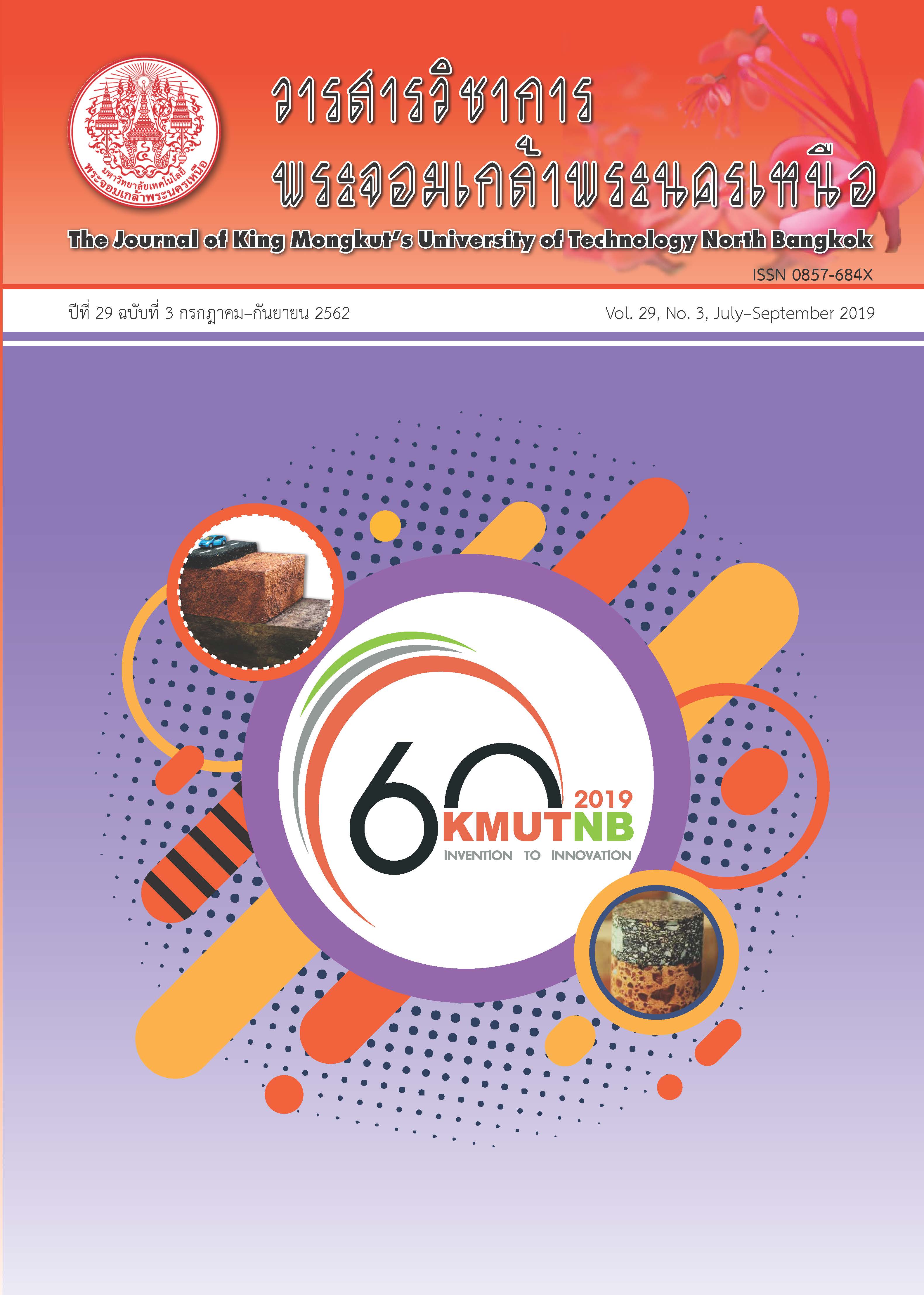การผันแปรเชิงพื้นที่และฤดูกาลของความเข้มข้นของก๊าซไนโตรเจนไดออกไซด์ในบรรยากาศเมืองพัทยา จังหวัดชลบุรี
Main Article Content
บทคัดย่อ
การได้รับก๊าซไนโตรเจนไดออกไซด์มีผลกระทบต่อสุขภาพของมนุษย์ ซึ่งแหล่งกำเนิดหลักของก๊าซไนโตรเจนไดออกไซด์มาจากการจราจรที่หนาแน่น งานวิจัยนี้มีวัตถุประสงค์เพื่อติดตามความเข้มข้นของก๊าซไนโตรเจนไดออกไซด์ในบรรยากาศช่วงฤดูหนาวและฤดูร้อนของพื้นที่เขตพาณิชยกรรม เขตที่อยู่อาศัยหนาแน่นมาก เขตที่อยู่อาศัยหนาแน่นน้อย และพื้นที่ตัวแทนค่าพื้นฐานในเมืองพัทยา จังหวัดชลบุรี โดยใช้วิธีการเก็บตัวอย่างด้วยหลอดเก็บตัวอย่างแบบแพสซีฟ ซึ่งทำการเก็บตัวอย่างในช่วงเดือนพฤศจิกายน พ.ศ. 2560 ถึง เดือนเมษายน พ.ศ. 2561 ทุกๆ 1 สัปดาห์ พบว่า ความเข้มข้นของก๊าซไนโตรเจนไดออกไซด์ในแต่ละพื้นที่อยู่ในช่วง 9.80–41.71, 8.36–29.01, 8.06–21.86 และ 5.14–27.19 ppbv ตามลำดับ โดยพื้นที่เขตพาณิชยกรรมมีค่าสูงที่สุดและแตกต่างอย่างมีนัยสำคัญทางสถิติ (p<0.05) ซึ่งมีธุรกิจโรงแรม สถานบันเทิง และร้านอาหาร ฯลฯ ทำให้มีการจราจรหนาแน่น นอกจากนี้ ความเข้มข้นของก๊าซไนโตรเจนไดออกไซด์ช่วงฤดูหนาวและฤดูร้อนไม่มีความแตกต่างอย่างมีนัยสำคัญทางสถิติ (p>0.05) ความเข้มข้นของก๊าซไนโตรเจนไดออกไซด์มีความสัมพันธ์ตรงกันข้ามกับความเร็วลม (r = –0.498 ถึง –0.625) ขณะที่ความชื้นสัมพัทธ์มีความสัมพันธ์โดยตรงสูง (r = 0.422 ถึง 0.600) อย่างไรก็ตาม การผันแปรเชิงพื้นที่และฤดูกาลของความเข้มข้นก๊าซไนโตรเจนไดออกไซด์อาจได้รับผลจากกิจกรรมของมนุษย์ เช่น การจราจรที่หนาแน่นมากกว่าปัจจัยทางอุตุนิยมวิทยา
Article Details
บทความที่ลงตีพิมพ์เป็นข้อคิดเห็นของผู้เขียนเท่านั้น
ผู้เขียนจะต้องเป็นผู้รับผิดชอบต่อผลทางกฎหมายใดๆ ที่อาจเกิดขึ้นจากบทความนั้น
เอกสารอ้างอิง
[2] F. Cibella, G. Cuttitta, R. D. Maggiore, S. Ruggieri, S. Panunzi, A. D. Gaetano, S. Bucchieri, G. Drago, M. R. Melis, S. L. Grutta, and G. Viegi, “Effect of indoor nitrogen dioxide on lung function in urban environment,” Environmental Research, vol. 138, pp. 8–16, 2015.
[3] M. Kattan, P.J. Gergen, P. Eggleston, C. M. Visness, and H. E. Mitchell, “Health effects of indoor nitrogen dioxide and passive smoking on urban asthmatic children,” Journal of Allergy and Clinical Immunology, vol. 120, no. 3, pp. 618–624, 2007.
[4] Pollution Control Department; PCD. (14 August, 2009). Air quality standards. Pollution Control Department. Bangkok, Thailand [Online]. Available: http://www.pcd.go.th/info_serv/reg_std_airsnd01.html.
[5] World Health Organization (WHO), “WHO air quality guidelines for particulate matter, ozone, nitrogen dioxide and sulfur dioxide,” Denmark, 2005, pp. 16–17.
[6] US-EPA National Ambient Air Quality Standards (NAAQS). (2018, December 15). NAAQS Table. Criteria Air Pollutants. North Carolina, The United States [Online]. Available: https://www.epa.gov/criteria-air-pollutants/naaqs-table#2.
[7] S. Choo-In, Sampling and Measurment of Pollutants in Ambient Air. Bangkok: Chulalongkorn university press: 2013, pp. 47–69.
[8] P. Martin, B. Cabanas, F. Villanueva, P. M. Gallego, I. Colmenar, and S. Salgado, “Ozone and nitrogen dioxide levels monitored in an urban area (Ciudad Real) in central-southern Spain,” Water Air & Soil Pollution, vol. 208, no. 1–4, pp. 305–316, 2009.
[9] P. D. Hien, M. Hangartner, P. M. Tan, and S. Fabian, “Concentrations of NO2, SO2, and benzene across Hanoi measured by passive diffusion samplers,” Atmospheric Environment, vol. 88, pp. 66–73, 2014.
[10] G. Artun, N. Polat, Z. Yay, O. Uzmez, A. Ari, T. Tuygun, T. Elbir, H. Altug, Y. Dumanoglu, T. Dogeroglu, A. Dawood, M. Odabasi, and E. Gaga, “An integrative approach for determination of air pollution and its health effects in a coal fired power plant area by passive sampling,” Atmospheric Environment, vol. 150, pp. 331–345, 2017.
[11] M. Zak, E. Melaniuk-Wolny, and K. Widziewicz, “The exporsure of pedestrians, drivers and road transport passengers to nitrogen dioxide,” Atmospheric Pollution Research, vol. 8, pp. 781–790, 2017.
[12] W. Geerts, “Top 100 cities destinations 2018,” Euromonitor International, pp.19, 2018.
[13] S. Siengchin, T. Wareesangad, P. Haesakul, P. Boonyasopon, and J. Suwarat. “Investigation and analysis for Pattaya’s progress in stepping towards,” The Journal of King Mongkut’s University of Technology North Bangkok, vol. 27, no. 2, pp. 379–391, 2017 (in Thai).
[14] Foreign Workers Administration office, (2018, October). Statistic of foreign works in Thailand, October 2018. Department of Employment, Ministry of Labour. Bangkok, Thailand [Online]. Available: https://www.doe.go.th/prd/alien/statistic/param/site/152/cat/82/sub/73/pull/sub_category/view/list-labell (in Thai).
[15] S. Bootdee, P. Chalemrom, and S. Chantara, “Validation and field application of tailor-made nitrogen dioxide passive sampler,” International Journal of Environmental Science and Technology, vol. 9, no.3, pp. 519–526, 2012.
[16] Department of Public Works and Town & Country Planning. (2015, April). Ministerial regulation to enforce the city plan, Pattaya city, Chon Buri province. (vol. 132, no. 26, pp. 1–17.) [Online]. Available: http://www.ratchakitcha.soc.go.th/DATA/PDF/2558/A/026/1.PDF (in Thai).
[17] S. S. Ahmad, P. Biiker, L. Emberson, and R. Shabbir, “Monitoring nitrogen dioxide levels in urban areas in Rawalpindi, Pakistan,” Water Air & Soil Pollution, vol. 220, no. 1, pp. 141–150, 2011.
[18] S. S. Ahmad and N. Aziz, “Spatial and temporal analysis of ground level ozone and nitrogen dioxide concentration across the twin cities of Pakistan,” Environmental Monitoring and Assessment, vol. 185, no. 4, pp. 3133–3147, 2013.
[19] S. Sillapapiromsuk and R. Janta, “Monitoring of ambient nitrogen dioxide concentrations in Lampang city by passive sampling,” Khon Kaen University Science Journal, vol. 46, no. 3, pp. 560–571, 2018 (in Thai).
[20] D. Alejo, M. C. Morales, J. B. Torre, R. Grau, L. Benes, R. V. Grieken, P. V. Espen, D. Sosa, and V. Nunez, “Seasonal trend of atmospheric nitrogen dioxide and sulfur dioxide over Nortg Santa Clara, Cuba,” Environmental Monitoring and Assessment, vol. 185, no. 7, pp. 60233–6033, 2013.
[21] S. Caballero, R. Esclapez, N. Galindo, E. Mantilla, and J. Crespo, “Use of a passive sampling network for the determination of urban NO2 spatiotemporal variations,” Atmospheric Environment, vol. 63, pp. 148–155, 2012.
[22] Z. Bozkurt, ö.ö. Üzmez, T. Dögeroglu, G. Artun, and E. O. Gaga, “Atmospheric concentration of SO2, NO2, ozone and VOCs in Duzce, Turkey using passive air sampler: Source, spatial and seasonal variations and health risk estimation,” Atmospheric Pollution Research, vol. 9, no. 6, pp. 1146–1156, 2018.
[23] Department of Mathematics and Computer Science, Faculty of Science, Chulalongkorn University, Probability and Statistics, Bangkok: Pithak printing, 2012, pp. 254–259 (in Thai).
[24] Y. Xie, B., Zhao, L. Zhang, and R. Luo, “Spatiotemporal variations of PM2.5 and PM10 concentrations between 31 Chinese cities and their relationships with SO2, NO2, CO, and O3,” Particuology, vol. 20, pp. 141–149, 2015.
[25] H. K. Elminir, “Dependence of urban air pollutants on meteorology,” Science of the Total Environment, vol. 350, no. 1–3, pp. 225–237, 2005.
[26] R. Jayamurugan, B. Kumaraval, S. Palanivelraja, and M. P. Chockalingan, “Influence of temperature, relative humidity and seasonal variability on ambient air quality in a coastal urban area,” International Journal of Atmospheric Science, vol. 2013, pp. 1–7, 2013.

